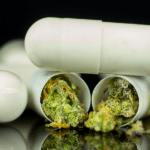On February 20, 2020, the journal Case Reports in Ophthalmogical Medicine published an article about a 56-year-old woman who died two days after ingesting a sublingual CBD tincture in addition to a cocktail of drugs prescribed to manage her pre-existing conditions.1
Sensationalized accounts of this report quickly circulated online, which misrepresented the incident as the “first death caused by CBD.”
The actual report, entitled “Commercial Cannabinoid Oil-Induced Stevens-Johnson Syndrome,” does not validate this alarming claim. That, however, won’t stop CBD cynics and drug war diehards from brandishing this case report as proof that cannabidiol is a dangerous substance.
Written by a team of researchers affiliated with the SUNY Upstate Medical University in Syracuse, New York, the case report describes a 56-year-old woman with “a medical history of herniated disc with chronic pain, hypertension, and coronary artery disease.” She had been taking three pharmaceuticals – famotidine, lisinopril-hydrochlorothiazide, and meloxicam – under a doctor’s supervision to treat her ailments.
In an effort to improve her health, the unidentified woman also had been using various CBD products for five years without ill effect. But a week after switching to a new CBD product called “Natural Native,” she was admitted to her local emergency room with a hideous rash and skin ulcers. She was diagnosed with Stevens-Johnson syndrome, which is usually triggered by a bad reaction to medications, causing skin tissue to die and detach. The mucous membranes of the eyes, mouth, and/or genitals are also adversely affected.2
She ultimately died of septic shock while hospitalized.
What Are Liposomes & What Is Their Role in This?
The case report notes the patient had previously used commercial CBD products “without side effects or associated allergic reactions [which] suggests involvement of other ingredients in this non-FDA-regulated product as the causative agent.”
What other ingredients may have been involved?
Shortly before she died, she had started taking a CBD tincture that utilized a liposomal delivery method.3 This may have been a key factor in her untimely demise.
Liposomes, composed of natural or synthetic lipid bilayers, are small spherical vesicles that can be used in product formulation as a means of enhancing the bioavailability of the active ingredient(s). Employed as a vehicle for administering drugs and nutraceuticals, this type of delivery system can facilitate a 10 to 100-fold increase in bioavailability depending on the compound in question. Sounds impressive, but that’s not always a good thing.
It’s worth noting that the pharmaceutical cocktail prescribed by her doctor included meloxicam, a non-steroidal anti-inflammatory drug, which reduces inflammatory pain by inhibiting COX enzymes that produce compounds, known as prostaglandins, that regulate the body’s inflammatory response.
When the liposomal CBD product was administered in conjunction with meloxicam and two other pharmaceuticals, the combination proved to be fatal.
Mechanisms at Play—It’s Not Just the CBD
How and why did this fatality occur?
Similar to grapefruit juice, CBD can cause drug-drug interactions due to its inhibitory or inductive actions on cytochrome P450 enzymes (CYPs). In particular, CBD inhibits both CYP2C9 and CYP3A4, the latter of which is responsible for metabolizing nearly 30 percent of prescribed pharmaceutical drugs.4-8 Significantly, the aforementioned meloxicam is also metabolized by CYP2C9 and CYP3A4.9
Unfortunately, this information was not included in the case report, which also neglected to indicate that grapeseed oil was one of the components of the CBD-infused liposomal formulation consumed by the patient. Grapeseed oil contains retinoids, which are Vitamin A derivatives that have many important functions throughout the body, including roles in vision, regulation of cell proliferation and differentiation, growth of bone tissue, immune function, and activation of tumor suppressor genes.10 But these compounds must be carefully dosed to avoid potential toxicity.
Product manufacturers should be cognizant of the chemical make-up of all the ingredients in their formulations, especially when using delivery methods designed to enhance bioavailabiity. Liposomal delivery likely enhanced not only the level of CBD in the patient but also the level of retinoid compounds found in the grapeseed oil. This, in turn, could lead to enhanced inhibition of CYP3A4 and CYP2C9, which would slow the metabolism of the meloxicam, further elevating its levels in the blood. Enhanced retinoid delivery likely exacerbated the situation by triggering the Stevens-Johnson syndrome.
Furthermore, the case report notes “complete chemical analysis from the patient’s commercial CBD oil was not performed.” Additionally, a certificate of analysis was not avilable on the website purveying this product, and we don’t know the dose of CBD that was administered or if other contaminants were also present.
To summarize: The problematic interaction between CBD, meloxicam, and retinoids was heightened due to the liposomal delivery of retinoid-containing grapeseed oil.
A Cautionary Tale
CBD skeptics and click-bait confabulators on the internet jumped to the conclusion that cannabidiol caused this woman’s death. But those who read the case report know that the actual cause of death was septic shock. While CBD’s inhibitory activity on CYP enzymes may have contributed to this, the chance combination of all these factors is what ultimately led to the woman’s death.
Let this be a lesson for CBD consumers, product formulators, and physicians alike – be careful!
Although cannabis is still federally illegal, it is essential that health professionals be well informed about potentially catastrophic drug-drug interactions. And it can’t be emphasized enough that patients must be honest with their doctors about their cannabis use, particularly if CBD is involved, given its modulating effects on various CYP enzymes.
Education and honest discourse are paramount if we are to prevent more tragedies such as this from occurring in the future.
Kyle Boyar is a cannabis scientist with a background in neurobiology, microbiology, and analytical chemistry. He is currently employed as the Director of Product Science at Tagleaf. Additionally, he also serves as the Vice Chair and Scholarship Committee Chair for the American Chemical Society’s Cannabis Chemistry Subdivision (CANN). Copyright, Project CBD. May not be reprinted without permission.
Footnotes
- Yin, Han Yang & Hadjokas, Nicholas & Mirchia, Kanish & Swan, Robert & Alpert, Samuel. (2020). Commercial Cannabinoid Oil-Induced Stevens-Johnson Syndrome. Case Reports in Ophthalmological Medicine. 2020. 1-5. 10.1155/2020/6760272.
- Dodiuk-gad RP, Chung WH, Valeyrie-allanore L, Shear NH. Stevens-Johnson Syndrome and Toxic Epidermal Necrolysis: An Update. Am J Clin Dermatol. 2015;16(6):475-93.
- Enhanced CBD Oil Extract Spray https://www.exspose.com/index.php?route=product/product&product_id=58 A… 3/9/20
- Zanger UM, Schwab M. Cytochrome P450 enzymes in drug metabolism: regulation of gene expression, enzyme activities, and impact of genetic variation. Pharmacol Ther. 2013;138(1):103-41.
- Michiru Nagao, Yukako Nakano, Masataka Tajima, Erika Sugiyama, Vilasinee Hirunpanich Sato, Makoto Inada, and Hitoshi Sato.Cannabis and Cannabinoid Research.ahead of print http://doi.org/10.1089/can.2019.0098
- Yamaori S, Ebisawa J, Okushima Y, Yamamoto I, Watanabe K. Potent inhibition of human cytochrome P450 3A isoforms by cannabidiol: role of phenolic hydroxyl groups in the resorcinol moiety. Life Sci. 2011;88(15-16):730-6.
- World Health Organization Expert Committee on Drug Dependence. Cannabidiol (CBD) Pre-review Report Agenda Item 5.2 and Peer Review. World Health Organization: Geneva, Switzerland, 2017. Google Scholar
- Yamaori, S., Koeda, K., Kushihara, M., Hada, Y., Yamamoto, I., & Watanabe, K. (2012). Comparison in the In Vitro Inhibitory Effects of Major Phytocannabinoids and Polycyclic Aromatic Hydrocarbons Contained in Marijuana Smoke on Cytochrome P450 2C9 Activity. Drug Metabolism and Pharmacokinetics, 27(3), 294–300. doi:10.2133/dmpk.dmpk-11-rg-107
- Ludwig E, Schmid J, Beschke K, Ebner T. Activation of human cytochrome P-450 3A4-catalyzed meloxicam 5’-methylhydroxylation by quinidine and hydroquinidine in vitro. J Pharmacol Exp Ther. 1999;290(1):1-8.
- Garavaglia J, Markoski MM, Oliveira A, Marcadenti A. Grape Seed Oil Compounds: Biological and Chemical Actions for Health. Nutr Metab Insights. 2016;9:59-64.
- Mawson AR, Eriator I, Karre S. Stevens-Johnson syndrome and toxic epidermal necrolysis (SJS/TEN): could retinoids play a causative role?. Med Sci Monit. 2015;21:133–143. Published 2015 Jan 12. doi:10.12659/MSM.891043.
Recommended Readings
Cannabis Instead of Polypharmacy?
Could cannabis be the safer alternative prescribers and patients are looking for?
Project CBD Releases Primer on Cannabinoid-Drug Interactions
Physicians and patients need to understand how cannabis interacts with common pharmaceuticals.
CBD Drug Interactions: What You Need to Know
Drug interactions can be useful and dangerous. Learn how CBD and THC may effect pain meds, statins, blood thinners, insulin and more.












